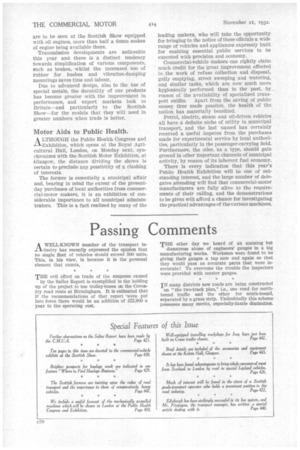The Scottish Show T E only comprehensive exhibition of commercial motors
Page 61

Page 62

If you've noticed an error in this article please click here to report it so we can fix it.
to be held in Great Britain this year opens to-day in Glasgow. A survey of the exhibits gives the impression that in a year of anxiety over the attitude of the legislature towards road transport, not to mention a year of unsettled trade conditions generally, manufacturers have spared no pains to improve and increase the efficiency of their commercial-vehicle products in every possible way, so as to emphasize still further the superiority of road transport for the majority of goods-carrying purposes, as well as for a vast field of passenger travel.
If youth be indispensable to initiative and energy, then, to judge by the splendid display of road motor A at Glasgow, automobile engineering is indeed a young industry. Let us not forget, however, the seniority of road transport, of which the motor vehicle but represents the latest implement. Roads were highways of inland carriage thousands of years ago and they have now come into their own again after a brief century of intrusion by a form of transport which, although protected by legislative action, does not appear to possess the same qualities of permanency.
At a time when the wheels of industry turn heavily against a load of inertia in the form of international trade depression, road transport offers a most necessary lubricant, giving service such as has never before been possible and at remarkably low operating costs. Cost of operation being so vitally important, it is heartening to be able to state that the oil engine advances in a promising manner, both technically and commercially, development proceeding at a healthy rate in response to a demand engendered by the definite fuel economy obtained with this form of power unit. No fewer than nine makes of chassis, including some of the most famous o19 are to be seen at the Scottish Show equipped with oil engines, more than half a dozen makes of engine being available there.
Transmission developments are noticeable this year and there is a distinct tendency towards simplification of various components, such as brakes, whilst the increased use of rubber for bushes and vibration-damping Mountings saves time and labour.
Due to advanced design, aLso to the use of special metals, the durability of our products has become greater with the improvement in performance, and export markets look to Britain—and particularly to the Scottish Show—for the models that they will need in greater numbers when trade is better.
Motor Aids to Public Health.
A LTHOUGH the Public Health Congress and -Exhibition, which opens at the Royal Agricultural Hall, London, on Monday next, synchronizes with the Scottish Motor Exhibition, at 'Glasgow, the distance dividing the shows is certain to preclude any possibility of a clashing of interests.
The former is essentially a municipal affair and, bearing in mind the extent of the presentday purchases of local authorities from commercial-motor makers, it is an exhibition of considerable importance to all municipal administrators. This is a fact realized by many of the leading makers, who will take the opportunity for bringing to the notice of these officials a wide range of vehicles and appliances expressly built for enabling essential public services to be executed with precision and economy.
Commercial-vehicle makers can rightly claim much credit for the 'great improvement effected in the work of refuse collection and disposal, gully emptying, street sweeping and watering, and similar tasks, which are now much more hygienically performed than in the past, by reason of the availability of specialized transport outfits. Apart from the saving of public money thus made possible, the health of the nation has materially benefited.
Petrol, electric, steam and oil-driven vehicles all have a definite niche of utility in municipal transport, and the last named has certainly received a useful impetus from the purchases made for experimental service by local authorities, particularly in the passenger-carrying field. Furthermore, the oiler, as a type, should gain ground in other important channels of municipal activity, by reason of its inherent fuel economy.
There is every indication that this year's Public Health Exhibition will be one of outstanding interest, and the large number of delegates attending will find that commercial-motor manufacturers are fully alive to the requirements of their calling, and the demonstrations to be given will afford a chance for investigating the practical advantages of the various machines.




















































































































































